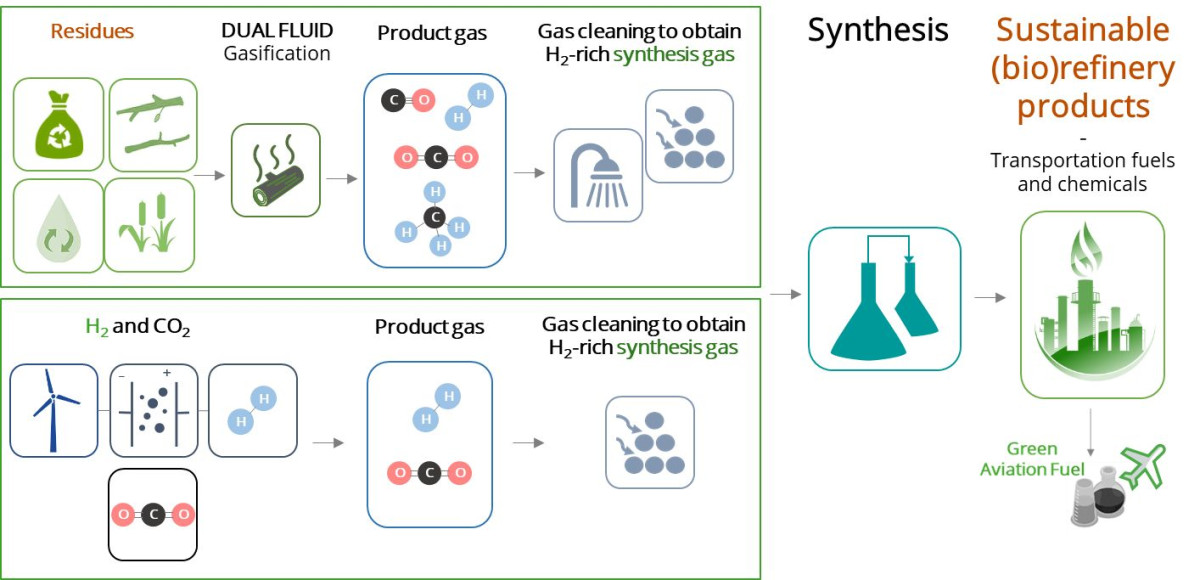Green Fuel and Chemicals
The production of synthesis gas and the downstream production of fuels and chemicals via synthesis processes represents a promising technological combination that can make a significant contribution to the defossilization of the energy, transport and chemical industries. In particular, the provision of renewable aviation fuel (SAF) is a key element in significantly reducing the carbon footprint of the transportation sector.
The COMET project Green Fuel and Chemicals uses two technological pathways: Fischer-Tropsch and alcohol synthesis.
Depending on the catalyst and process parameters used, both processes can convert synthesis gas (through gas generation), e-synthesis gases (from electrolysis) as well as H2 and CO2 directly at the catalyst (iron catalyst required for FT synthesis).
Fischer-Tropsch synthesis (FTS):
The conversion of H2 and CO into a wide range of products with hydrocarbon chain lengths from C1 to more than C60 is achieved using a Slurry Bubble Column Reactor (SBCR). In this SBCR, the catalyst particles are suspended in a liquid wax phase and the gas bubbles, which enter the SBCR from below via a gas distributor plate, keep the catalyst in suspension. The presence of good mixing behavior within the SBCR leads to high CO conversion rates as well as high heat transfer rates, resulting in isothermal conditions along the reactor. This SBCR technology was further scaled up on a pilot scale in 2016 to obtain one barrel (~159 liters) per day of FT products. In 2021, the project partner KIT started its research activities in the field of direct CO2 utilization via Fischer-Tropsch synthesis.

Methanol (Alcohol) synthesis:
From 2010 to 2016, BEST GmbH and TU Wien conducted research in the field of mixed alcohol synthesis and gained knowledge about the construction, commissioning and operation of an alcohol-based synthesis plant. A simple gas purification plant (mainly consisting of gas scrubbers and/or steam reforming plant) and a fixed-bed synthesis reactor served as the test setup. In 2021, BEST GmbH started its own research activities in the field of gasification of residues and waste fractions using the latest available double fluidized bed technology developed by its scientific partner TU Vienna.
The COMET research project aims to combine these innovative technologies (gasification of residues, FTS and alcohol synthesis) in one project in order to create the basis for the introduction of synthetic paraffinic kerosene (SPK). By-products such as olefins, waxes and alcohols can be used as feedstock in the chemical industry and thus further increase the profitability of the entire process chain.
The following objectives are targeted by the conducted research activities:
- Determining the most economical option and pathway for the production of SAF and chemicals (using biomass residues, waste, CO2 or a combination thereof)
- Determination of technically suitable and sufficiently available raw material
- Proof of the feasibility of SBCR technology for use on a large scale
- Demonstration of an Alcohol-to-Jet (AtJ) process
- Ensure compliance of the used process chains with ASTM international standard
Projektvolumen
EUR 3.160.000
Start of project
2023-04-01 (ongoing)
Supported by
COMET, FFG
Projektpartner
- University of Natural Resources and Life Sciences, Vienna (BOKU)
- TU Wien
- Karlsruhe Institute of Technology (KIT)
- Hansen & Rosenthal GmbH & Co.KG
- Aichernig Engineering GmbH
- Wien Energie GmbH
- Caphenia GmbH
- Dieffenbacher Energy GmbH
- Solarbelt FairFuel gGmBH
- Yosemite Clean Energy
Contact
Area Management

Matthias Kuba
matthias.kuba@best-research.eu

Gerald Weber
gerald.weber@best-research.eu
